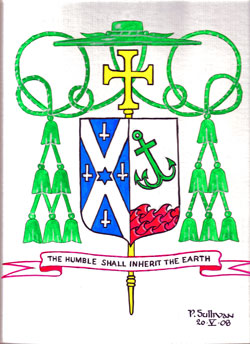Official Website of the
Catholic Diocese of Little Rock
Bishop Anthony Basil Taylor
Episcopal Coat of Arms
The following explanation of Bishop Anthony B. Taylor's coat of arms was provided by Deacon Paul Sullivan of Providence, R.I. To learn more, see his episcopal insignia.
Blazon
Arms impaled. Dexter: Azure, inverted Latin Crosses Argent, upon a saltair of the second a six-pointed star of the first. Sinister: Argent, a cruciform tridentine anchor vert diagonal leaning downward suspended over eaves gules.
Significance
The arms of Bishop Taylor appear on the left (facing) side of the shield, joined with those of the Diocese of Little Rock and surrounded by the bishop's motto and the heraldic symbols of his office. The diocesan arms of Little Rock are composed of the Marian colors, silver (the same as white in heraldry) and blue. They honor Mary as the patroness of the United States under her title of the Immaculate Conception.
Since Peter is the "petra" (rock) upon which the Church was founded by Jesus Christ, the diocese is represented by small inverted silver crosses in memory of his crucifixion and his head to the earth. The cross in the form of the letter X is the Cross of St. Andrew, the patron of the diocesan cathedral and the baptismal patron of Bishop Andrew Byrne, its first ordinary.
 The star of six points is derived from the coat of arms of Pope Gregory XVI, who established the Diocese of Little Rock on Nov. 28, 1843. Bishop Taylor's personal arms proclaim that the cross of Jesus is our secure hope in times of adversity.
The star of six points is derived from the coat of arms of Pope Gregory XVI, who established the Diocese of Little Rock on Nov. 28, 1843. Bishop Taylor's personal arms proclaim that the cross of Jesus is our secure hope in times of adversity.
The red waves represent the water of baptism and the blood of the Eucharist as prefigured in the events of the Exodus: the waters of the Nile turned into blood, the blood of the Passover Lamb sprinkled on the Israelites' doorposts, prefiguring that of Jesus poured out on the cross, and their passage through the Red Sea, prefiguring our salvation from the power of sin and death through baptism.
They also represent the pastoral challenge of the Church today: the blood of martyrs like Blessed Stanley Rother of Oklahoma, the blood of the victims of abortion and the Rio Grande across which immigrants continue to come. The red waves also refer to the Red River which unites Texas, the state of Bishop Taylor's birth, with Oklahoma and Arkansas, the states in which he has served as a priest and bishop.
The green cruciform tridentine anchor represents Christian hope anchored by faith in the Blessed Trinity. The color green and the anchor are traditional symbols of hope. The cruciform anchor leans downward to represent a preferential option for the poor: Jesus coming down from heaven to save us and we who follow him leaning downward to lift up those who are oppressed.
Bishop Taylor's episcopal motto is "The Humble Shall Inherit the Earth." It is taken from Psalm 37:11 and is quoted by Jesus in the Beatitudes in Matthew 5:5. Bishop Taylor notes that humble in the motto should be understood in the sense of the underlying Hebrew word Anawim. In English, humble and meek describe a person's attitude, but the Hebrew refers also to humble circumstances, being marginalized by external factors of poverty and bigotry.









